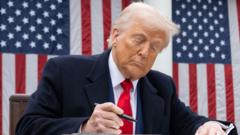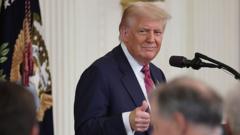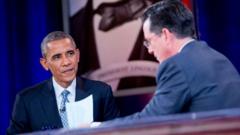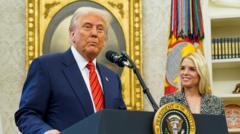As the anxiety in global markets heightened due to anticipated trade wars, President Trump announced a temporary halt on increased tariffs, shifting the economic strategy just as tensions were about to escalate further.
Trump Hits the Brakes on Rising Tariffs, Reshapes Trade Landscape

Trump Hits the Brakes on Rising Tariffs, Reshapes Trade Landscape
In a surprising turn of events, President Trump pauses considerable tariffs on numerous nations for 90 days amidst market turmoil.
---
For several days, President Trump and his administration remained steadfast in their commitment to enacting extensive "reciprocal" tariffs on an array of countries. Despite previous dismissals of reports suggesting a possible 90-day pause, the administration confirmed this reprieve—accompanied by some exceptions—marking a significant shift in their approach to international trade and economic negotiations.
The announcement has drawn mixed reactions, as the stock market experienced a brief boost following news of the tariffs' suspension. Treasury Secretary Scott Bessent highlighted that over 75 nations had contacted the U.S. amid the tumultuous atmosphere, hinting at potential discussions moving forward. However, the pause has raised questions about the implications for U.S. trade relationships, particularly with the EU, Mexico, and Canada, which had previously avoided the baseline tariffs.
Trump’s decision, communicated through a post on Truth Social, revealed the complexities surrounding the implementation of these tariffs. Many of the president’s aides were quick to assert that the strategy was part of a deliberate negotiation tactic rather than a retreat driven by market concerns.
The latest developments prompted Trade Adviser Peter Navarro to emphasize that the tariff situation unfolded as intended, while Press Secretary Karoline Leavitt portrayed the global reception as supportive of U.S. economic leadership. Amid these optimistic narratives, however, market analysts noted growing investor concerns and a bond market decrease, aligning with a sense of unease over economic stability.
Addressing the public, Trump acknowledged the market's "glum" outlook and the collective anxiety circulating among investors, admitting that disruption in the economy was a lingering issue. In contrast, Senate Minority Leader Chuck Schumer criticized the administration’s instability, framing Trump’s actions as chaotic governance rather than effective leadership.
Going forward, the U.S. appears to be walking a fine line in international relations, attempting to ease tensions with hesitant allies while maintaining a wavering stance on China's trade policies, where tariffs have reached up to 125%. As the country navigates through these uncertain waters over the next 90 days, anticipation looms for how Trump will proceed once the pause concludes, and whether stability can once again be institutionalized amid the shifting global economic landscape.
For several days, President Trump and his administration remained steadfast in their commitment to enacting extensive "reciprocal" tariffs on an array of countries. Despite previous dismissals of reports suggesting a possible 90-day pause, the administration confirmed this reprieve—accompanied by some exceptions—marking a significant shift in their approach to international trade and economic negotiations.
The announcement has drawn mixed reactions, as the stock market experienced a brief boost following news of the tariffs' suspension. Treasury Secretary Scott Bessent highlighted that over 75 nations had contacted the U.S. amid the tumultuous atmosphere, hinting at potential discussions moving forward. However, the pause has raised questions about the implications for U.S. trade relationships, particularly with the EU, Mexico, and Canada, which had previously avoided the baseline tariffs.
Trump’s decision, communicated through a post on Truth Social, revealed the complexities surrounding the implementation of these tariffs. Many of the president’s aides were quick to assert that the strategy was part of a deliberate negotiation tactic rather than a retreat driven by market concerns.
The latest developments prompted Trade Adviser Peter Navarro to emphasize that the tariff situation unfolded as intended, while Press Secretary Karoline Leavitt portrayed the global reception as supportive of U.S. economic leadership. Amid these optimistic narratives, however, market analysts noted growing investor concerns and a bond market decrease, aligning with a sense of unease over economic stability.
Addressing the public, Trump acknowledged the market's "glum" outlook and the collective anxiety circulating among investors, admitting that disruption in the economy was a lingering issue. In contrast, Senate Minority Leader Chuck Schumer criticized the administration’s instability, framing Trump’s actions as chaotic governance rather than effective leadership.
Going forward, the U.S. appears to be walking a fine line in international relations, attempting to ease tensions with hesitant allies while maintaining a wavering stance on China's trade policies, where tariffs have reached up to 125%. As the country navigates through these uncertain waters over the next 90 days, anticipation looms for how Trump will proceed once the pause concludes, and whether stability can once again be institutionalized amid the shifting global economic landscape.






















